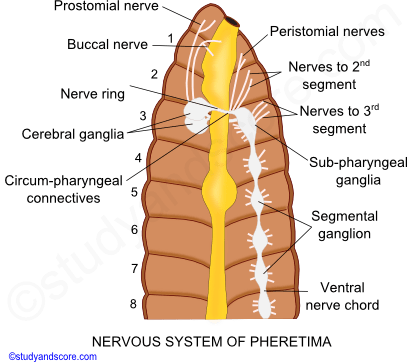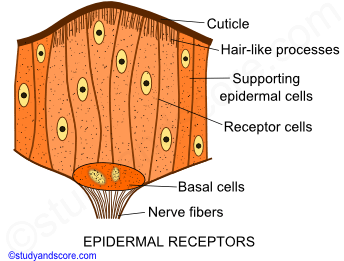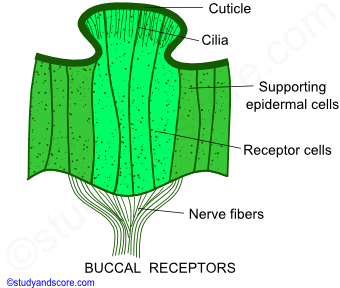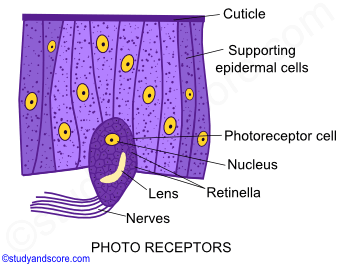The nervous system of earthworm consists of three parts namely,
Central Nervous system: It includes following structures:
Cerebral ganglia- There are two pear shaped cerebral ganglia fused together at 3rd segment called brain.
Circumpharyngeal connective- Two circumpharyngeal connectives arise from each cerebral ganglion laterally. They encircle pharynx and fuse at 4th segment. The fused portion is called sub pharyngeal ganglia.
Ventral nerve cord- It is white rod like structure, which starts running from sub- pharyngeal ganglia towards posterior end. In each segment, ventral nerve cord swells which is called segmental ganglia. Actually, there are two cords fuse together to form single ventral nerve cord. Ventral nerve cord is composed of nerve cells and nerve fibers. There are 4 giant fibers on mid dorsal side of nerve cord which conducts impulses rapidly. The outer covering of ventral nerve cord is called peritoneum.
Peripheral nervous system: It includes nerve fibers or nerve, which arises from central nervous system.
Sympathetic nervous system: It consists of nerve plexuses extensively branched and distributed beneath epidermis, alimentary canal that is connected to circumpharyngeal connectives.

Working of nervous system: The sensory cells from different parts of the body receive impulse. Sensory fibers (afferent fibers) carry impulse to central nervous system. Motor fibers (efferent fibers) carry impulse back to effective organs or different parts of body from central nervous system. In earthworm, impulse is also travel from one ganglion to another ganglion through ventral nerve cord.
Earthworms have well-developed sense organs. These sense organs are simple in structure consisting of one single cell or a group of specialized ectodermal cells. Pheretima has three types of sense organs:
Epidermal receptors: These receptors are well distributed all over the epidermis. They are more abundant on the lateral sides and ventral surface of the body. Each receptor has an elevated cuticle covering a group of tall, slender and columnar receptor cells, bearing small hair-like processes at their outer ends and connected with nerve fibers at their inner ends. They are surrounded on all sides by ordinary supporting epidermal cells. They are tactile in function and also respond to chemical stimuli and changes in the temperature.

Buccal receptors: These receptors are restricted only to the epithelium of the buccal chamber. They are similar to the epidermal receptors except that they have broader outer ends. Also the sensory hairs are more deeply situated and better developed. These receptor cells have deeply seated nucleus. These receptors are gustatory and olfactory in function. They also respond to chemical stimuli.

Photo-receptors: These are photo sensitive or light sensitive receptors which are restricted only to the dorsal surface of the body. They are more numerous on prostomium and peristomium but their number gradually decreases as we move towards the posterior end of the body. They are totally absent in the clitellar region.

Each photoreceptor consists of a single ovoid cell with a nucleus and clear cytoplasm containing a network of neurofibrils and a small transparent L-shaped lens or phaosome, made up of a hyaline substance. The lens focuses the light from all directions on neurofibrils. All the neurofibrils converge to an afferent nerve fibre which leaves the cell at its base to join the central nervous system. Photoreceptors enable worms to judge the intensity and duration of light.

- Share with your friends! -
Login to post your comment here...
- or with social Account -